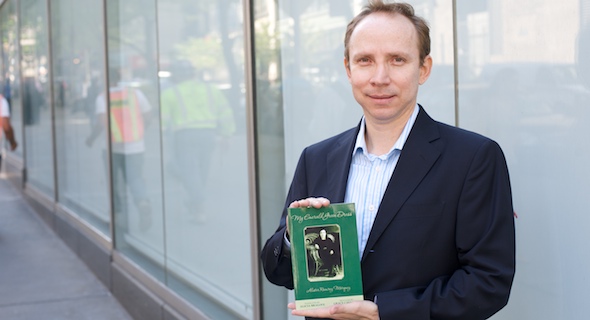
Alister Ramírez Márquez, Professor of Spanish Language and Hispanic American literature dedicates his fictional memoir, My Emerald Green Dress to “all the women who have fighter spirit.”
Originally titled Mi vestido verde esmeralda (Ala de Mosca, 2003), the book debuted in Spanish, and was then published in Italian before the recent English translation by Alicia Bralove, with a prologue by Grace Cavalieri.
A century of turmoil
“Clara does not despair, she is a feminist before the term was coined,” Cavalieri writes of the central character, whose 90-year life and narrative parallels Colombia’s turbulent 20th Century, including decades known as La Violencia, when the Liberal and Communist parties’ guerilla units fought against the Conservative Party, and many rural communities were trapped in the conflict.
“Liberals, conservatives were all affected,” says Ramírez Márquez. “Almost 300,000 people died.” Clara, reflecting the fate of millions of Colombians during that period, was forced by the unrest to leave her home and migrate from a rural to urban part of the country.
“She is based on different people I know and interviewed in Colombia,” Ramírez Márquez says. “She represents what we refer to as Las Matronas, very powerful women. For many years, they held the family together.”
A woman’s perspective
Las Matronas not only held their families together in a time when many people disappeared or were murdered, they endured great physical hardship.
“The migration was extremely difficult because of the rivers and mountains,” says Ramírez Márquez. “There was no rail road; people had to walk incredible distances, and in this book, the story of that migration is told through the eyes of a woman—usually it is told only through a man’s point of view.”
Playwrite, poet and literary critic Cavalieri, who founded and produces Public Radio’s highly acclaimed program from the Library of Congress, “The Poet and the Poem,” writes in the book’s prologue that it promotes “the bold theory that a woman can become the protagonist in a pioneer story,” and Ramírez Márquez compares Clara’s search for a better life “to the period in United States history when many people were moving to the West, looking for gold.”
Her journey, critics have noted, evokes the magic realism of One Hundred Years of Solitude by renown South American novelist Gabriel García Márquez, and takes her through forests, mountains and swamps to the western region of Quindío and the city of Armenia, the heart of Colombia’s coffee and banana industries.
Translating more than words
My Emerald Green Dress won the 2005 Best International Literary Prize by the Art Critics Circle of Chile, and took ten years to write, Ramírez Márquez says, while the English translation took three years.
“It was written originally in Spanish—Colombian Spanish,” Ramírez Márquez clarifies. “You have to understand the culture of Colombia to translate it.”
Alicia Bralove, who translated the book into English, holds a Ph.D. in French Literature from the CUNY Graduate Center and is on the Modern Languages faculty at Bronx Community College. Her scholarly work examines the role of women in war, especially women in the Spanish Civil War (1936-1939), and she lived for many years in Colombia.
That, and her understanding of war and the “displacement of poor people,” Ramírez Márquez explains, lends insight to her translation and helps convey the political undertones of Clara’s journey.
“It’s not only about the 90 years of her existence,” he says, “it’s about what happened in Colombia during that time. Migrations happen continually not just country to country, but within countries.”
The main character’s emerald green dress affirms, in a sense, her determination to survive those brutal years.
“Emerald green means life, to me,” says Ramírez Márquez. “The character is very realistic, earthy. She doesn’t idealize love.” The photo on the cover of the book is actually Ramírez Márquez’s grandmother, who he feels is an apt reflection of the character’s stoic spirit. “She doesn’t smile,’ he says. “She has dignity. She is very discrete, sober.”
EDITOR’S NOTE: In addition to having authored My Emerald Green Dress, Alister Ramírez Márquez has written the novels Reportaje a Once Escritores Norteamericanos (Planeta Editorial, 1996), ¿Quién se Robó los Colores? (Wayside, Massachusetts 1999), Andrés Bello: crítico (Ala de Mosca, 2005), and Los sueños de los hombres se los fuman las mujeres (Planeta Editorial, 2009). He is also a regular contributor for the major Latin American newspaper, El Tiempo of Colombia.
STORY HIGHLIGHTS
- My Emerald Green Dress was published in Spanish and Italian, before the recent English translation by Alicia Bralove, with a prologue by Grace Cavalieri.
- It won the prestigious 2005 Best International Literary Prize by the Art Critics Circle of Chile.
- The story chronicles Colombia’s turbulent 20th Century—from one woman’s perspective.

